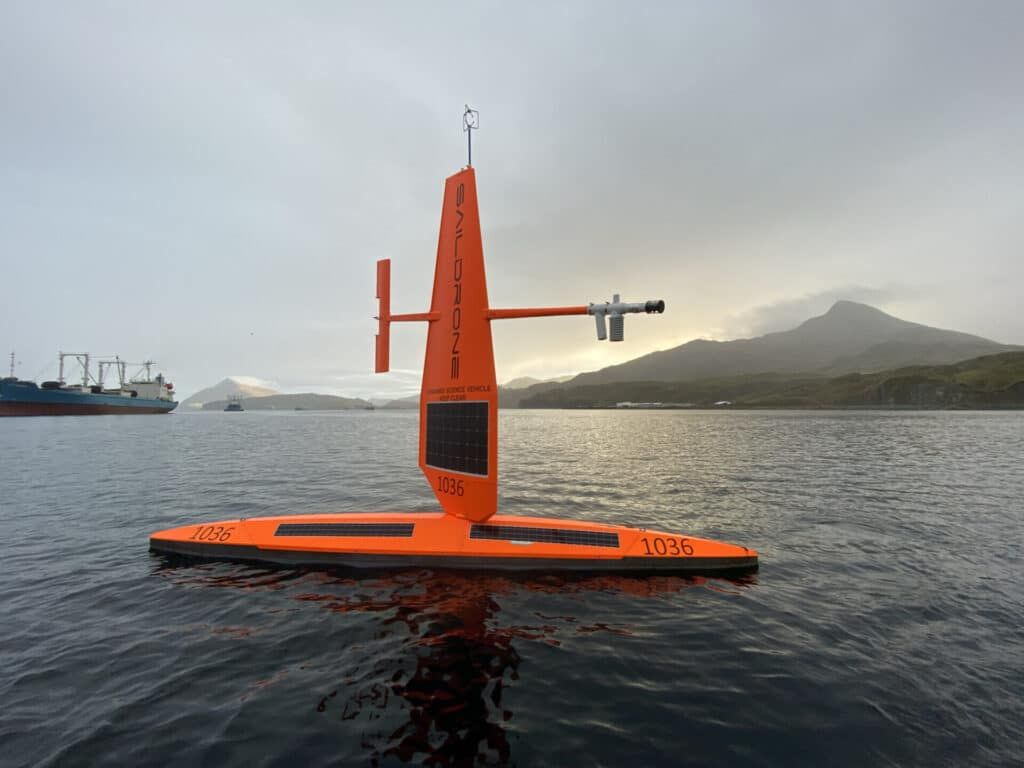Why drone boats are an overhyped Achilles’ fleet
By Jonathan Panter, Johnathan Falcone | February 9, 2023
 A saildrone (Credit: National Oceanic and Atmospheric Administration)
A saildrone (Credit: National Oceanic and Atmospheric Administration)
In October 2022, seven small unmanned surface vessels slipped into Crimea’s port of Sevastopol to attack the Russian Black Sea Fleet. These Ukrainian drone boats caused little damage, but the public relations campaign that followed was spectacular. Within days, point-of-view footage from the attack spread across the internet. The video recordings sparked cheers around the Western world, exaltations of a naval revolution, and an international crowd-funding campaign to build Ukraine’s autonomous fleet of the future.
In the United States, drone boats, or unmanned surface vessels, form a cornerstone of the Navy’s newest strategic agenda. Early last year, the Navy’s brand-new unmanned squadron received its first vessel prototypes from Ghost Fleet Overlord, the Pentagon’s official name for its former program to test and evaluate these new systems. Meanwhile, in the Persian Gulf, the Navy—working alongside private industry—has been testing Saildrone, a small craft that looks like it sounds.
But setting aside, for a moment, the point-of-view videos and “Ghost Fleet” terminology, it’s important to balance the exuberant publicity with pragmatism. Academic research indicates that alleged “revolutions in military affairs” are often overstated. This kind of overstatement has been applied most recently to aerial drones, and some knowledgeable observers are beginning to question over-enthusiastic projections about unmanned surface vessels, as well.
Big promises about military technology always deserve skepticism, but especially when they come from arms manufacturers. The Navy, quite judiciously, has encouraged industry competition. But even competing contractors share one interest: convincing the military, Congress, and the public that unmanned vessels are the future. Whether they truly are—or whether the hype is clouding awareness of these vessels’ vulnerabilities—requires evaluation.
Unmanned surface vessels: Like crypto, often a technology in need of a use case. With their associated techno-military lingo (such as AI, autonomy, distributed force architecture), unmanned surface vessels cut an imposing figure to the non-expert. This gives rise to a hand-waving common with many emerging technologies that implies “you just don’t get it; trust us.” But some limitations of unmanned vessels are more about simple physics and human ethics than about high technology.
First, wind, waves, and seawater quickly and severely degrade engineering systems at sea. With no people onboard to conduct repairs—as we have argued elsewhere—the more complex a platform is, the more likely it is to fail. If, to avoid failing, E.T. phones home for help, its trackable electromagnetic emissions make it a sitting duck. Second, any mission that requires ethical decisions or evaluating ambiguity will retain a latent capacity for human intervention. Unmanned vessels are therefore unlikely to perform the US Navy’s primary missions without off-ship human support, which makes them attractive cyber targets.
Communications render all unmanned surface vessels today cyber vulnerable by factory default. The driving technology behind many unmanned naval craft, often lionized as artificial intelligence, is more aptly described as graduated autonomy. Some naval drones are controlled remotely, while others have varying degrees of autonomy, such as in-the-loop systems (wherein human permission is required for some steps) or on-the-loop systems (where humans serve in a supervisory role and can intervene if they desire). Currently, none are truly autonomous and—given legal, ethical, and escalation concerns—few will likely ever be.
Ukraine’s drone boat attack illustrates these limits. A suicide attack against fixed, in-port targets is one of the easiest use cases for pure autonomy. The targets are identified and approved in advance, and they don’t move. The travel distance is short, so GPS is unnecessary, and target discrimination is possible with existing image recognition software. And yet, the drones still had visible antennae, suggesting a retained capacity for human control via high-frequency communications or satellite.
Off-ship communications for data transmission and receipt, or for external control, are an established cyber-attack vector. Encrypted communications provide substantial protection, but pose their own problems, including failures to load cryptographic keys (which interrupt communications) and the danger that, if the vessel is captured, the keys and systems will be compromised. Even without durable, secure communications, reliable access to satellites is critical for rudimentary, yet critical, weather and position data or for mission updates. Whether constant or intermittent, line-of-sight and satellite communications are susceptible to electronic and cyber warfare attacks, from jamming to denial-of-service, flooding, and eavesdropping.
At the onset of Russia’s invasion, Ukraine’s command-and-control networks suffered a successful attack on a private satellite company. Fortunately for the Ukrainians, Starlink has been able to provide consistent and reliable service, enabling military operations. However, like most action-reactions in warfare, the advantage provided by Elon Musk’s low-orbit constellation is likely to be challenged and short-lived. As Musk revealed in October, Russian efforts to hack and jam such satellites are well underway, and in a future conflict between more powerful states, anti-satellite weapons could also play a role.
Even without communication uplinks and downlinks, unmanned vessels are still vulnerable to cyber exploitation via both hardware and software supply chains. From design until destruction, these systems must be assessed as “assumed compromised.” This relates to the physical requirements mentioned earlier: maintaining resilient engineering systems in the maritime environment for stable propulsion, power, and cooling. Except for Taiwan and Israel, no state domestically produces the advanced semiconductors required for the computing power behind autonomous systems. Chip design software is usually imported, too.
One aerial drone Russia used in Ukraine, for instance, was imported from Iran, and constructed from 80 percent American parts (with the remainder from Canada, Japan, Taiwan, China and the Netherlands). A hardware vulnerability could quite literally be etched into a drone’s most vital organ and be immune to any patch. And this is a tiny system. For larger craft, like the US Navy’s “medium displacement” unmanned surface vessel, the system requirements increase exponentially, not linearly.
Ukraine’s pitch for an autonomous Navy is logical. When Russian sea control results in cruise missiles killing civilians, disruptive maritime guerilla operations offer both a reprieve and meaningful propaganda opportunities. But as the United States races to field unmanned surface vessels, the hype should not overshadow severe operational use-case and cybersecurity limitations. To be sure, some unmanned and autonomous naval technologies will probably contribute meaningfully to future naval warfare. They can, for instance, serve supporting roles by gathering oceanographic data or laying mines, which is evolutionary, not revolutionary.
As with many Silicon Valley-inspired trends, high-tech terms like autonomy and AI in the debate about unmanned surface vessels too easily substitute for prudence and skepticism. The American public, and Congress, should consider that when industry says something new is both cheaper and more effective, it’s probably not both.
Together, we make the world safer.
The Bulletin elevates expert voices above the noise. But as an independent nonprofit organization, our operations depend on the support of readers like you. Help us continue to deliver quality journalism that holds leaders accountable. Your support of our work at any level is important. In return, we promise our coverage will be understandable, influential, vigilant, solution-oriented, and fair-minded. Together we can make a difference.
Keywords: Navy, Russia-Ukraine, Ukraine, drone boats, drones, unmanned surface vessel
Topics: Disruptive Technologies















